Play video — original link
Play video
Play video

500 South Congress Planned Unit Development (PUD) C814-2024-0001 Sean Watson Environmental Program Coordinator Watershed Protection C I T Y O F A U S T I N W A T E R S H E D P R O T E C T I O N D E P A R T M E N T 500 South Congress PUD C 8 1 4- 2 0 2 4 - 0 0 0 1 C I T Y O F A U S T I N W A T E R S H E D P R O T E C T I O N D E P A R T M E N T Site Inf ormation • • A u s t i n F u l l P u r p o s e T o t a l s i t e a r e a = 6 . 4 8 a c r e s J u r i s d i c t i o n • • • • • • C o u n c i l D i s t r i c t 9 E a s t B o u l d i n C r e e k a n d L a d y B i r d L a k e W a t e r s h e d s , U r b a n W a t e r s h e d S o u t h S h o r e C e n t r a l D i s t r i c t W a t e r f r o n t O v e r l a y P r o p o s e d r e z o n i n g t o a l l o w f o r m i x e d u s e d e v e l o p m e n t / P U D T w o R i m r o c k C E F s s o u t h o f s i t e C r i t i c a l W a t e r Q u a l i t y Z o n e ( C W Q Z ) a n d 1 0 …

ENVIRONMENTAL COMMISSION MOTION 20250604-002 Date: June 4, 2025 Subject: 500 S Congress, C814-2024-0001 Location: 500 S Congress, Austin, TX 78704 Motion by: Hanna Cofer Seconded by: David Sullivan WHEREAS, The Environmental Commission recognizes the applicant is requesting Planned Unit Development (PUD) zoning for a 6.48-acre; and WHEREAS, The Environmental Commission recognizes that the project is located within the Urban Watersheds of Lady Bird Lake and East Bouldin Creek, includes portions of the 100-year floodplain and Critical Water Quality Zone (CWQZ); and WHEREAS, The Commission acknowledges that the applicant has proposed numerous environmental enhancements and elements of superiority; and WHEREAS, the Environmental Commission recognizes that City staff recommends the PUD with numerous conditions as provided in back-up material; THEREFORE, the Environmental Commission recommends approval of the Mixed-Use PUD with the following conditions: 1. Implement on-site recycling and reuse of existing concrete and other demolition materials to the extent feasible. 2. Require the use of low-intensity, shielded, dark-sky compliant lighting along the creek corridor and riparian zones. 3. Commit to certifying the riparian restoration area and adjacent natural spaces as a Texas Wildscape with Texas Parks and Wildlife Department or as a Certified Wildlife Habitat with the National Wildlife Federation. 4. Require an additional 5% of all parking spaces be constructed with the capability to support future installation of electric vehicle (EV) charging stations. VOTE 8-1 For: Isabella Changsut, Haris Qureshi, Martin Luecke, Justin Fleury, Jennifer Bristol, Hanna Cofer, Annie Fierro, David Sullivan Against: Richard Brimer Recuse: None Absent: Mariana Krueger, Ashika Ganguly 1 Approved By: Jennifer Bristol, Environmental Commission Chair CONDITIONS TO BE INCLUDED FROM CITY STAFF RECOMMENDATION: a. Section 25-8-63(C)(12) (Impervious Cover Calculations) as modified by the PUD b. Section 25-8-261 (Critical Water Quality Zone Development) as modified by the PUD c. Section 25-8-213(C) (Water Quality Control Standards) as modified by the PUD d. Comply with the City of Austin’s Green Building Program for a 2-star rating. e. Comply with the most current AEGB Light Pollution Reduction criteria available at the time of site plan f. Comply with the most current AEGB Bird Collision Deterrence criteria available at the time of site plan g. Provide water quality treatment with rainwater harvesting cisterns and rain gardens. h. Reduce site impervious cover by 5% i. Remove 8000 sqft of concrete from the CWQZ, reducing the existing impervious cover in the CWQZ from 48.2% to 20.7% j. Use natural channel design techniques as …

ENVIRONMENTAL COMMISSION REGULAR CALLED MEETING MINUTES Wednesday, June 4, 2025 The Environmental Commission convened in a Regular meeting on Wednesday, June 4, 2025, at 6310 Wilhelmina Delco Drive in Austin, Texas. Chair Bristol called the Environmental Commission Meeting to order at 6:01 p.m. Commissioners in Attendance: Jennifer Bristol, Hanna Cofer, Richard Brimer, Isabella Changsut, Justin Fleury, Annie Fierro, Martin Luecke, Haris Qureshi, David Sullivan Commissioners in Attendance Remotely: None Commissioners Absent: Mariana Krueger, Ashika Ganguly PUBLIC COMMUNICATION: GENERAL Craig Nazor, concerns on the Little Walnut Creek Flood Risk Reduction Project APPROVAL OF MINUTES 1. Approve the minutes of the Environmental Commission Regular Meeting on May 21, 2025 The minutes of the Environmental Commission Regular Meeting on May 21, 2025, were approved on Commissioner Cofer’s motion, Commissioner Brimer’s second on a 9-0 vote. Commissioners Krueger and Ganguly were absent. PUBLIC HEARINGS 2. Name: 500 S Congress, C814-2024-0001 Applicant: Armbrust & Brown, L.L.P (Amanda Hendrix) Location: 500 S Congress, Austin, TX 78704 Council District: District 9 Staff: Sean Watson, Environmental Program Coordinator, (512) 963-2167, Sean.Watson@austintexas.gov; Leslie Lilly, Environmental Conservation Program Manager, (512) 535-8914, Leslie.lilly@austintexas.gov Applicant request: Planned Unit Development Zoning Staff Recommendation: Staff recommended with conditions Speakers: Sean Watson, WPD 1 Roy Wayley, Sierra Club Bobby Levenski, SOS Michael Iannacone, Related Companies Dawood Rouben, Related Companies Liz Johnston, Interim Environmental Officer, WPD Sherri Sirwatis, Planner, Planning Department Matt Yeager, TGB Partners Leslie Lilly, WPD Jonathon Ogren, Siglo Group Jonathan McKee, Garza engineers A motion to close the public hearing passed on Commissioner Sullivan’s motion, Commissioner Cofer’s second, on a 9–0 vote. Commissioners Bristol, Cofer, and Fleury were absent. Krueger and Ganguly were absent. A motion to recommend the 500 S Congress with conditions passed on Commissioner Cofer’s motion, Commissioner Sullivan’s second, on an 8–1 vote. Commissioners Krueger and Ganguly were absent. WORKING GROUP UPDATES 3. Update on response to Council Resolution 20241121-073 on Bird-Friendly Design – Environmental Commission Chair Jennifer Bristol Item conducted as posted. No action taken. FUTURE AGENDA ITEMS Commissioner Qureshi requested a presentation on the post-op of the recent storm. Liz Johnston stated that the Homeland Security office does an after-action report that we can share. Commissioner Sullivan requested commissioners share ideas for Bond projects. Commissioner Changsut requested a presentation on wildfire risk. Staff will send over the presentation recording from May. Chair Bristol asked for a presentation to learn more about recycling concrete. ADJOURNMENT Chair Bristol adjourned the …
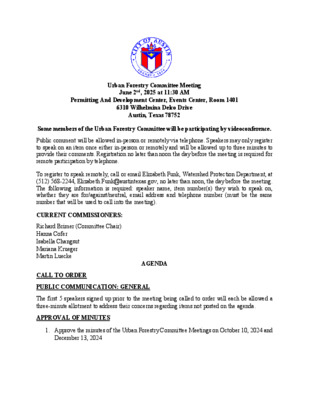
Urban Forestry Committee Meeting June 2nd, 2025 at 11:30 AM Permitting And Development Center, Events Center, Room 1401 6310 Wilhelmina Delco Drive Austin, Texas 78752 Some members of the Urban Forestry Committee will be participating by videoconference. Public comment will be allowed in-person or remotely via telephone. Speakers may only register to speak on an item once either in-person or remotely and will be allowed up to three minutes to provide their comments. Registration no later than noon the day before the meeting is required for remote participation by telephone. To register to speak remotely, call or email Elizabeth Funk, Watershed Protection Department, at (512) 568-2244, Elizabeth.Funk@austintexas.gov, no later than noon, the day before the meeting. The following information is required: speaker name, item number(s) they wish to speak on, whether they are for/against/neutral, email address and telephone number (must be the same number that will be used to call into the meeting). CURRENT COMMISSIONERS: Richard Brimer (Committee Chair) Hanna Cofer Isabella Changsut Mariana Krueger Martin Luecke CALL TO ORDER PUBLIC COMMUNICATION: GENERAL AGENDA The first 5 speakers signed up prior to the meeting being called to order will each be allowed a three-minute allotment to address their concerns regarding items not posted on the agenda. APPROVAL OF MINUTES 1. Approve the minutes of the Urban Forestry Committee Meetings on October 10, 2024 and December 13, 2024 DISCUSSION ITEMS 2. Discussion and presentation on Austin’s Heritage Tree Ordinance – Naomi Rotramel, City Arborist, Development Services Department 3. Discussion and presentation on Austin’s tree canopy and related programs – Emily King, Urban Forester, Development Services Department 4. Discussion and presentation on Ashe Juniper’s role in the Central Texas ecosystem – Lisa O-Donnell, Environmental Science Senior, Wildland Conservation, Austin Water 5. Discussion on goals and future meeting times for the Urban Forestry Committee – Richard Brimer, Chair FUTURE AGENDA ITEMS ADJOURNMENT The City of Austin is committed to compliance with the American with Disabilities Act. Reasonable modifications and equal access to communications will be provided upon request. Meeting locations are planned with wheelchair access. If requiring Sign Language Interpreters or alternative formats, please give notice at least 2 days (48 hours) before the meeting date. Please 512-568-2244, call Elizabeth Elizabeth.Funk@austintexas.gov; for additional information; TTY users route through Relay Texas at 711. Protection Department, Funk, Watershed at
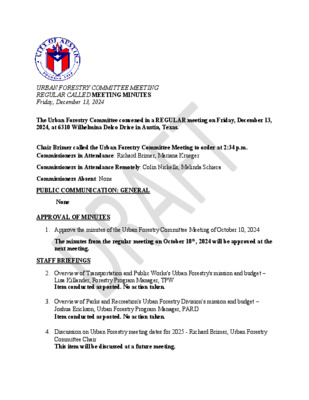
URBAN FORESTRY COMMITTEE MEETING REGULAR CALLED MEETING MINUTES Friday, December 13, 2024 The Urban Forestry Committee convened in a REGULAR meeting on Friday, December 13, 2024, at 6310 Wilhelmina Delco Drive in Austin, Texas. Chair Brimer called the Urban Forestry Committee Meeting to order at 2:34 p.m. Commissioners in Attendance: Richard Brimer, Mariana Krueger Commissioners in Attendance Remotely: Colin Nickells, Melinda Schiera Commissioners Absent: None PUBLIC COMMUNICATION: GENERAL None APPROVAL OF MINUTES 1. Approve the minutes of the Urban Forestry Committee Meeting of October 10, 2024 The minutes from the regular meeting on October 10th, 2024 will be approved at the next meeting. STAFF BRIEFINGS 2. Overview of Transportation and Public Works's Urban Forestry's mission and budget – Lisa Killander, Forestry Program Manager, TPW Item conducted as posted. No action taken. 3. Overview of Parks and Recreation's Urban Forestry Division's mission and budget – Joshua Erickson, Urban Forestry Program Manager, PARD Item conducted as posted. No action taken. 4. Discussion on Urban Forestry meeting dates for 2025 - Richard Brimer, Urban Forestry Committee Chair This item will be discussed at a future meeting. FUTURE AGENDA ITEMS None Chair Brimer adjourned the meeting at 3:11 p.m. without objection.
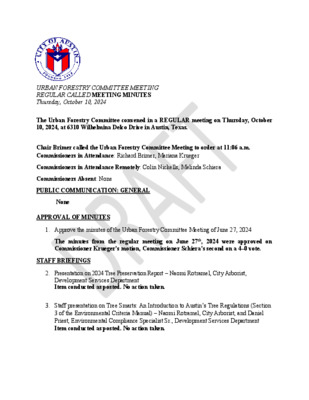
URBAN FORESTRY COMMITTEE MEETING REGULAR CALLED MEETING MINUTES Thursday, October 10, 2024 The Urban Forestry Committee convened in a REGULAR meeting on Thursday, October 10, 2024, at 6310 Wilhelmina Delco Drive in Austin, Texas. Chair Brimer called the Urban Forestry Committee Meeting to order at 11:06 a.m. Commissioners in Attendance: Richard Brimer, Mariana Krueger Commissioners in Attendance Remotely: Colin Nickells, Melinda Schiera Commissioners Absent: None PUBLIC COMMUNICATION: GENERAL None APPROVAL OF MINUTES 1. Approve the minutes of the Urban Forestry Committee Meeting of June 27, 2024 The minutes from the regular meeting on June 27th, 2024 were approved on Commissioner Krueger’s motion, Commissioner Schiera’s second on a 4–0 vote. STAFF BRIEFINGS 2. Presentation on 2024 Tree Preservation Report – Naomi Rotramel, City Arborist, Development Services Department Item conducted as posted. No action taken. 3. Staff presentation on Tree Smarts: An Introduction to Austin’s Tree Regulations (Section 3 of the Environmental Criteria Manual) – Naomi Rotramel, City Arborist, and Daniel Priest, Environmental Compliance Specialist Sr., Development Services Department Item conducted as posted. No action taken. DISCUSSION AND ACTION ITEMS 4. Discussion and recommendation on strategies to improve Austin’s tree canopy – Richard Brimer, Urban Forestry Committee Chair A motion to table the item passed on Commissioner Krueger’s motion, Commissioner Brimer’s second on a 3-0 vote. Commissioner Nickells was off dais. FUTURE AGENDA ITEMS None Chair Brimer adjourned the meeting at 12:41 p.m. without objection.
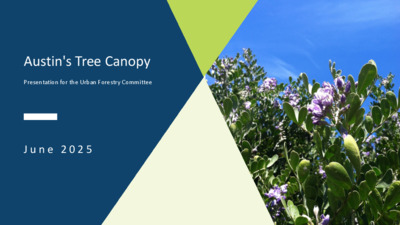
Austin's Tree Canopy Presentation for the Urban Forestry Committee J u n e 2 0 2 5 Presentation Overview • Austin's urban forest stats • Urban forest management • Canopy cover • Additional tools Significant Benefits https://texasforestinfo.tamu.edu/urbanforeststats/assets/standard/AustinTX2022.pdf Urban Forest Management Development Services Parks & Recreation Public Works Austin Energy Austin Fire • Parks Forestry • PWD Forestry • Utility Forestry • Wildfire Division • Urban Forest Program • City Arborist Program Watershed Protection • Env. Resource Mgmt • Policy & Planning • Field Operations Canopy Cover Heading 41% Canopy Cover 39K Acres of new canopy needed to meet 50% canopy cover goal. https://storymaps.arcgis.com/stories/d9ba0b99c60b4b8395414a09c4533949 The City of Austin measures tree canopy every 4 years using the calculation: tree canopy area divided by land area. The canopy cover number uses the City of Austin's boundary, inclusive of full purpose, limited purpose, and extraterritorial jurisdictions in May 2023. Analysis provided by Alan Halter, IT Geospatial Analyst Senior, Development Services Department, Urban Forest Program Additional tools My City's Trees • Urban Forest Inventory and Analysis data • • Inventory statistics Summary Reports https://mct.tfs.tamu.edu/app Additional tools Tree Canopy • National tree canopy database • View tree canopy cover and land cover classes • Planning tool built-in https://hub.treesatwork.org/ Emily King Urban Forester Emily.King@AustinTexas.gov Follow Nature in the City for events, updates, job postings, and more! facebook.com/NatureCityATX instagram.com/NatureCityATX
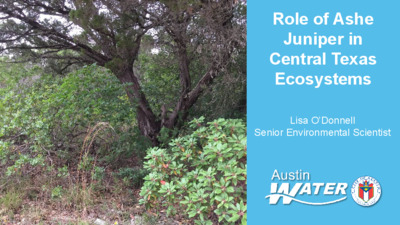
Role of Ashe Juniper in Central Texas Ecosystems Lisa O’Donnell Senior Environmental Scientist Ashe Juniper (“cedar”) is both a pioneer… …and an old growth species Ashe Juniper Helps to Build Nutrient-Rich Soils That Are High In Organic Carbon ) % ( I N O B R A C C N A G R O L I O S 16.00 14.00 12.00 10.00 8.00 6.00 4.00 2.00 0.00 Open Young Junipers Old Junipers Juniper-Oak Canopies Keep Temperatures Cooler and More Stable During Summer Droughts Summer Soil Temperatures No Vegetation Forest Canopy 120⁰ F 86 ⁰ F air temperature = 104 ⁰ F 5 Roots are also important! • Help infiltrate water into the ground • Promote carbon sequestration and storage in soil Ashe juniper and shin oak roots (and Dr. Brian Pickles) Cotterell Cave Bray (1904) believed the forests of the Edwards Plateau were critical to protecting water supplies downstream and advocated for their protection: • Forests build soil • Forests protect soil from erosion, keep it cool and moist • Forest soils act as a sponge and promote recharge He concluded: “For all these reasons, forests tend to conserve the water supply and to maintain full springs and an even flow of streams.” Ashe juniper supports a diversity of rare and endemic plants Texas Amorpha Cedar Sage Texas Madrone Twistleaf Yucca Buckley’s Tridens © Chuck Sexton Canyon Mock-Orange Heller’s Marbleseed Shade During Summer Drought is Critical to Oak Seedling Survival l t o P / s g n i l d e e S e v L i f o # August: Under Canopy August: No Shade Texas Red Oak Seedlings (planted as acorns in fall 2017) caged, 60% shade caged, no shade uncaged, no shade 35 30 25 20 15 10 5 0 -5 Both living and dead trees (“nurse trees”) can promote the growth of other plants Texas red oak sapling growing under living tree Carolina buckthorn sapling growing under dead tree Juniper also provides essential habitat for a variety of wildlife Robin Golden-cheeked Warbler Cedar Waxwing Juniper Hairstreak 11 Endangered and rare species that depend on or occur in juniper-oak ecosystems © John Ingram © John Ingram Contribution of “cedar” to economic growth and development “With the exception of cedar, the hill timber finds a market chiefly as fuel, of which enormous quantities are consumed….Cedar likewise is extensively consumed as fuel and in charcoal burning; but its …

Urban Forestry Committee Meeting June 2nd, 2025 Naomi Rotramel, City Arborist History of Austin’s Tree Ordinance Margret Hofmann, 1925-2012 Hofmann Oaks Park History of Austin’s Tree Ordinance 1983 - Tree Preservation Ordinance 2010 - Heritage Tree Ordinance The Larger the Tree, the Greater the Protection 4 Land Development Code 25-8.B.1 • Prohibits removal of Protected or Heritage trees without a permit • 8"+ trees – preserve "to extent feasible" on site plan applications • Defines removal - physical removal, over pruning, or excessive root disturbance • Approval criteria for removal: • Reasonable use • Reasonable access • Dead, Diseased, or Imminent Hazard • Variances and appeals • • Administrative rules – preservation criteria, protection Creates position of City Arborist to implement tree regulations requirements, mitigation Rules implementing LDC 25-8.B.1 are found in Section 3 of the Environmental Criteria Manual What are the Tree Regulations? Land Development Code 25-8, Subchapter B, Article 1 Division 1 – General Provisions Definitions Authorizes Rules Application Requirements Division 2 – Protected Trees Approval Criteria for Removal Division 3 – Heritage Trees Approval Criteria for Removal Variances Environmental Criteria Manual Section 3 3.3 - Survey Requirements Survey and Plan Depictions Hill Country Roadway Ordinance 3.5 - Design Criteria Protection (3.5.2) Mitigation (3.5.4) 3.6 - Tree Protection Environmental Criteria Manual Section 3 Regulated Trees in Austin Preserved Removed/ Mitigated Must meet criteria in ECM 3.5.2 Must fall under LDC 25-8-624 Regulated Trees in Austin • Includes hackberry, Ashe juniper, invasives, hazardous trees, etc. • Certain species are designated as Heritage Trees when they reach 24” diameter (LDC 25-8-602) • Palm trees are not regulated under the COA tree ordinance. Hackberry Ash Juniper Heritage Trees in Austin • Is a tree that has a diameter of 24 inches or more, measured four and one-half feet above natural grade, and is one of the following species: • Texas Ash, Bald Cypress, American elm ,Cedar elm, Texas madrone, Bigtooth maple, All oaks, Pecan, Arizona walnut, and Eastern Black walnut • 25-8-641 – Prohibits removal unless a permit is issued and is only issued if a variance is approved under Section 25-8-642 (Administrative Variance) or 25- 8-643 (Land Use Commission Variance). • The requirements apply to trees on private and public property. • Without a variance, a damaged heritage tree may be removed that is an imminent hazard to life or property if removed within seven days of being damaged. The …
Play audio

Regular Meeting of the Environmental Commission May 21, 2025 at 6:00 PM Permitting And Development Center, Events Center, Room 1405 6310 Wilhelmina Delco Drive Austin, Texas 78752 Some members of the Environmental Commission will be participating by videoconference. The meeting may be viewed online at: http://www.austintexas.gov/page/watch-atxn-live Public comment will be allowed in-person or remotely via telephone. Speakers may only register to speak on an item once either in-person or remotely and will be allowed up to three minutes to provide their comments. Registration no later than noon the day before the meeting is required for remote participation by telephone. To register to speak remotely, call or email Elizabeth Funk, Watershed Protection Department, at (512) 568-2244, Elizabeth.Funk@austintexas.gov, no later than noon the day before the meeting. The following information is required: speaker name, item number(s) they wish to speak on, whether they are for/against/neutral, email address and telephone number (must be the same number that will be used to call into the meeting). CURRENT COMMISSIONERS: Haris Qureshi Justin Fleury Mariana Krueger, Vice Chair Martin Luecke Hanna Cofer, Secretary Ashika Ganguly Annie Fierro Jennifer Bristol, Chair David Sullivan Richard Brimer Isabella Changsut CALL TO ORDER PUBLIC COMMUNICATION: GENERAL AGENDA The first 10 speakers signed up prior to the meeting being called to order will each be allowed a three-minute allotment to address their concerns regarding items not posted on the agenda. APPROVAL OF MINUTES 1. Approve the minutes of the Environmental Commission Regular Meeting on May 7, 2025 1 PUBLIC HEARINGS 2. Name: Camelback PUD Amendment #3, C814-86-023.01 Applicant: Armbrust & Brown, L.L.P (Amanda Morrow) Location: 6505 Bridge Point Parkway, Austin, TX 78730 Council District: District 10 Staff: Leslie Lilly, Environmental Conservation Program Manager, (512) 535-8914, Leslie.lilly@austintexas.gov; Sean Watson, Environmental Program Coordinator, (512) 963-2167, Sean.Watson@austintexas.gov Applicant request: Amend a Planned Unit Development Staff Recommendation: Staff recommended with conditions DISCUSSION ITEMS 3. Presentation and discussion on Austin Resource Recovery’s Road to Zero Waste – Ron Romero, Assistant Director, Austin Resource Recovery FUTURE AGENDA ITEMS ADJOURNMENT The City of Austin is committed to compliance with the American with Disabilities Act. Reasonable modifications and equal access to communications will be provided upon request. Meeting locations are planned with wheelchair access. If requiring Sign Language Interpreters or alternative formats, please give notice at least 2 days (48 hours) before the meeting date. Please call Elizabeth Funk, Watershed Protection Department, at (512) 568-2244, Elizabeth.Funk@austintexas.gov, Watershed Protection Department, …
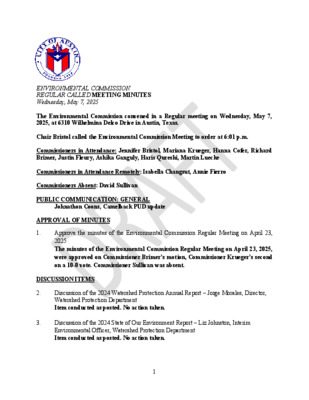
ENVIRONMENTAL COMMISSION REGULAR CALLED MEETING MINUTES Wednesday, May 7, 2025 The Environmental Commission convened in a Regular meeting on Wednesday, May 7, 2025, at 6310 Wilhelmina Delco Drive in Austin, Texas. Chair Bristol called the Environmental Commission Meeting to order at 6:01 p.m. Commissioners in Attendance: Jennifer Bristol, Mariana Krueger, Hanna Cofer, Richard Brimer, Justin Fleury, Ashika Ganguly, Haris Qureshi, Martin Luecke Commissioners in Attendance Remotely: Isabella Changsut, Annie Fierro Commissioners Absent: David Sullivan PUBLIC COMMUNICATION: GENERAL Johnathon Coons, Camelback PUD update APPROVAL OF MINUTES 1. Approve the minutes of the Environmental Commission Regular Meeting on April 23, 2025 The minutes of the Environmental Commission Regular Meeting on April 23, 2025, were approved on Commissioner Brimer’s motion, Commissioner Krueger’s second on a 10-0 vote. Commissioner Sullivan was absent. DISCUSSION ITEMS 2. 3. Discussion of the 2024 Watershed Protection Annual Report – Jorge Morales, Director, Watershed Protection Department Item conducted as posted. No action taken. Discussion of the 2024 State of Our Environment Report – Liz Johnston, Interim Environmental Officer, Watershed Protection Department Item conducted as posted. No action taken. 1 PUBLIC HEARINGS 4. 5. Name: PSH – LifeWorks at Tillery, SP-2025-0031C.SH Applicant: 3423 Tillery LLC Location: 819 Tillery Street, Austin, TX, 78702 Council District: District 3 Staff: Naomi Rotramel, City Arborist, Development Services Department Applicant request: The applicant is seeking the removal of a Heritage tree with a single stem over 30 inches in diameter. Staff Recommendation: The request meets City Arborist approval criteria set forth in LDC 25-8-624(A)(2). The variance is recommended. Speakers: Naomi Rotramel, City Arborist, DSD Conor Kenny, Developer of the site Liz Schoenfeld, Lifeworks (applicant) Nhat Ho, Civilitude, Civil Engineer with the project A motion to close the public hearing passed on Commissioner Krueger’s motion, Commissioner Lueke’s second, on a 10–0 vote. Commissioner Sullivan was absent. Chair Bristol called for a recess at 7:53. Chair Bristol reconvened the meeting at 8:01. A motion to recommend the heritage tree removal request with conditions passed on Commissioner Cofer’s motion, Commissioner Bristol’s second, on an 8–1 vote. Commissioner Krueger voted against. Commissioner Brimer abstained. Commissioner Sullivan was absent. Name: McLemore Tract Multifamily Water and Wastewater Service Extension Request #6139 and 6140 Applicant: John Lewis, Development Associate, CWS Capital Partners, LLC Location: 10656 N FM 620 Rd, Austin, Texas 78726 Council District: Not applicable Staff: Kaela Champlin, Environmental Program Coordinator, (512) 974-3443, Kaela.Champlin@austintexas.gov Applicant request: Water and Wastewater Service Extension …
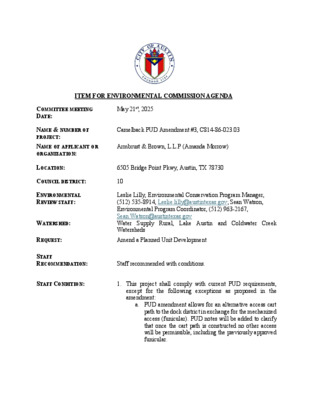
ITEM FOR ENVIRONMENTAL COMMISSION AGENDA COMMITTEE MEETING DATE: NAME & NUMBER OF PROJECT: NAME OF APPLICANT OR ORGANIZATION: May 21st, 2025 Camelback PUD Amendment #3, C814-86-023.03 Armbrust & Brown, L.L.P (Amanda Morrow) LOCATION: 6505 Bridge Point Pkwy, Austin, TX 78730 COUNCIL DISTRICT: 10 ENVIRONMENTAL REVIEW STAFF: WATERSHED: Leslie Lilly, Environmental Conservation Program Manager, (512) 535-8914, Leslie.lilly@austintexas.gov; Sean Watson, Environmental Program Coordinator, (512) 963-2167, Sean.Watson@austintexas.gov Water Supply Rural, Lake Austin and Coldwater Creek Watersheds REQUEST: Amend a Planned Unit Development STAFF RECOMMENDATION: STAFF CONDITION: Staff recommended with conditions. 1. This project shall comply with current PUD requirements, except for the following exceptions as proposed in the amendment: a. PUD amendment allows for an alternative access cart path to the dock district in exchange for the mechanized access (funicular). PUD notes will be added to clarify that once the cart path is constructed no other access will be permissible, including the previously approved funicular. b. The cart path will not impact critical environmental comply with and otherwise features (CEFs) environmental regulations. c. No additional cut will be allowed other than what is already provided by the approved PUD d. Changes to the allotments and allowable depths of fill will be allowed as proposed by this amendment. ZONING CHANGE REVIEW SHEET CASE: C814-86-023.03 – Camelback PUD Amendment #3 DISTRICT: 10 ZONING FROM / TO: PUD, to amend a previously approved land use plan, allowable uses, site development regulations, and request modifications to cut and fill requirements. ADDRESS: 6505, 6511 ½ and 6915 Bridge Point Parkway SITE AREA (Total): 143.04 acres PROPERTY OWNER: Loop 360 Land LP (Jonathan Coon) AGENT: Armbrust & Brown, PLLC (Richard T. Suttle, Jr.) CASE MANAGER: Nancy Estrada (512-974-7617, nancy.estrada@austintexas.gov) STAFF RECOMMENDATION: The Staff recommendation is to grant the third amendment to planned unit development (PUD) district zoning, as shown in the Proposed PUD Amendment summary on page 3 of this report and as referenced in the replacement Exhibits C, D2, E, and G. ENVIRONMENTAL COMMISSION ACTION: May 21, 2025: ZONING AND PLATTING COMMISSION ACTION / RECOMMENDATION: June 3, 2025: CITY COUNCIL ACTION: June 5, 2025: ORDINANCE NUMBER: ISSUES: The Shepherd Mountain Neighborhood Association, Lake Austin Collective, and the 2222 Coalition of Neighborhood Associations have submitted correspondence in support of the proposed Camelback PUD amendment. All correspondence is provided at the end of this report. C814-86-023.03 Page 2 On May 9, 2025, the applicant submitted a letter to modify the …
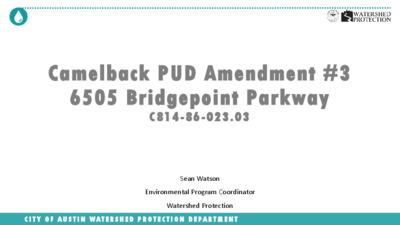
Camelback PUD Amendment #3 6505 Bridgepoint Parkway C814-86-023.03 Sean Watson Environmental Program Coordinator Watershed Protection C I T Y O F A U S T I N W A T E R S H E D P R O T E C T I O N D E P A R T M E N T Camelback Planned Unit Development (PUD) C814-86-023.03 C I T Y O F A U S T I N W A T E R S H E D P R O T E C T I O N D E P A R T M E N T 1 C I T Y O F A U S T I N W A T E R S H E D P R O T E C T I O N D E P A R T M E N T 2 Background • 1 4 3 . 0 6 7 6 a c r e s o f l a n d , u p t o 2 8 9 r e s i d e n t i a l u n i t s • Wa t e r S u p p l y Ru r a l , Au s t i n F u l l P u r p o s e J u r i s d i c t i o n • L a ke Au s t i n a n d C o l d C r e e k Wa t e r s h e d s • D r i n k i n g Wa t e r P ro t e c t i o n Z o n e • P ro p o s e d r ev i s i o n t o a n ex i s t i n g P U D w i t h 6 4 s i n g l e f a m i l y h o m e s • N u m e ro u s C E F s ex i s t o n s i t e • C o u n c i l D i s t r i c t 1 0 C I T Y O F A U S T I N W A T E R …
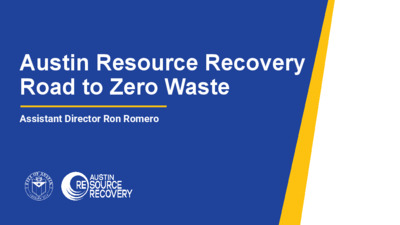
Austin Resource Recovery Road to Zero Waste Assistant Director Ron Romero About Austin Resource Recovery Our Mission We provide essential services that protect people and our planet. Our Vision Driving the global transformation of traditional waste management to sustainable resource recovery. Curbside Collection for Trash, Recyclables and Compost Brush, Bulk and HHW On Demand Services Recycle and Reuse Drop-off Center (RRDOC) Residential Services Citywide Services • Litter Abatement • Street sweeping is provided for major roads, residential streets and bike lanes • Circular Business Services • Commercial Compliance Unit • Construction and Demolition Recycling Ordinance • Special Events Ordinance • Universal Recycling Ordinance • Zero Waste Business Rebate Business Services Community Programs • Austin Reuse Directory • Fix-It Austin • Generation Zero • MoveOut ATX • Zero Waste Block Leaders Questions
Play video
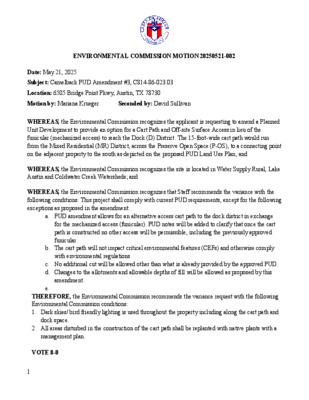
ENVIRONMENTAL COMMISSION MOTION 20250521-002 Date: May 21, 2025 Subject: Camelback PUD Amendment #3, C814-86-023.03 Location: 6505 Bridge Point Pkwy, Austin, TX 78730 Motion by: Mariana Krueger Seconded by: David Sullivan WHEREAS, the Environmental Commission recognizes the applicant is requesting to amend a Planned Unit Development to provide an option for a Cart Path and Off-site Surface Access in lieu of the funicular (mechanized access) to reach the Dock (D) District. The 15-foot-wide cart path would run from the Mixed Residential (MR) District, across the Preserve Open Space (P-OS), to a connecting point on the adjacent property to the south as depicted on the proposed PUD Land Use Plan; and WHEREAS, the Environmental Commission recognizes the site is located in Water Supply Rural, Lake Austin and Coldwater Creek Watersheds; and WHEREAS, the Environmental Commission recognizes that Staff recommends the variance with the following conditions: This project shall comply with current PUD requirements, except for the following exceptions as proposed in the amendment: a. PUD amendment allows for an alternative access cart path to the dock district in exchange for the mechanized access (funicular). PUD notes will be added to clarify that once the cart path is constructed no other access will be permissible, including the previously approved funicular. b. The cart path will not impact critical environmental features (CEFs) and otherwise comply with environmental regulations. c. No additional cut will be allowed other than what is already provided by the approved PUD. d. Changes to the allotments and allowable depths of fill will be allowed as proposed by this amendment. e. THEREFORE, the Environmental Commission recommends the variance request with the following Environmental Commission conditions: 1. Dark skies/ bird friendly lighting is used throughout the property including along the cart path and dock space. 2. All areas disturbed in the construction of the cart path shall be replanted with native plants with a management plan. VOTE 8-0 1 For: Mariana Krueger, Richard Brimer, Isabella Changsut, Annie Fierro, Ashika Ganguly, Martin Luecke, Haris Qureshi, David Sullivan Against: None Recuse: None Absent: Jennifer Bristol, Hanna Cofer, Justin Fleury Approved By: Attest: Elizabeth Funk, Environmental Commission Liaison 2
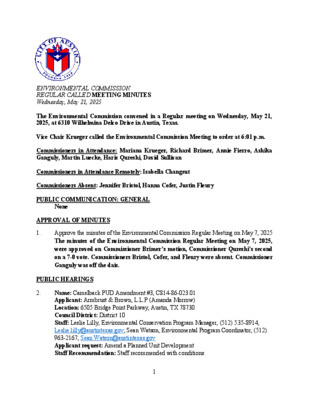
ENVIRONMENTAL COMMISSION REGULAR CALLED MEETING MINUTES Wednesday, May 21, 2025 The Environmental Commission convened in a Regular meeting on Wednesday, May 21, 2025, at 6310 Wilhelmina Delco Drive in Austin, Texas. Vice Chair Krueger called the Environmental Commission Meeting to order at 6:01 p.m. Commissioners in Attendance: Mariana Krueger, Richard Brimer, Annie Fierro, Ashika Ganguly, Martin Luecke, Haris Qureshi, David Sullivan Commissioners in Attendance Remotely: Isabella Changsut Commissioners Absent: Jennifer Bristol, Hanna Cofer, Justin Fleury PUBLIC COMMUNICATION: GENERAL None APPROVAL OF MINUTES 1. Approve the minutes of the Environmental Commission Regular Meeting on May 7, 2025 The minutes of the Environmental Commission Regular Meeting on May 7, 2025, were approved on Commissioner Brimer’s motion, Commissioner Qureshi’s second on a 7-0 vote. Commissioners Bristol, Cofer, and Fleury were absent. Commissioner Ganguly was off the dais. PUBLIC HEARINGS 2. Name: Camelback PUD Amendment #3, C814-86-023.01 Applicant: Armbrust & Brown, L.L.P (Amanda Morrow) Location: 6505 Bridge Point Parkway, Austin, TX 78730 Council District: District 10 Staff: Leslie Lilly, Environmental Conservation Program Manager, (512) 535-8914, Leslie.lilly@austintexas.gov; Sean Watson, Environmental Program Coordinator, (512) 963-2167, Sean.Watson@austintexas.gov Applicant request: Amend a Planned Unit Development Staff Recommendation: Staff recommended with conditions 1 Speakers: Sean Watson, WPD Johnathon Coons, Applicant Leslie Lilly, WPD Allison __ , Kimley-Horn Naomi Rotramel, City Arborist, DSD A motion to close the public hearing passed on Commissioner Sullivan’s motion, Commissioner Brimer’s second, on a 10–0 vote. Commissioners Bristol, Cofer, and Fleury was absent. A motion to recommend the Camelback PUD Amendment #3 with conditions passed on Commissioner Krueger’s motion, Commissioner Sullivan’s second, on a 8–0 vote. Commissioners Bristol, Cofer, and Fleury was absent. DISCUSSION ITEMS 3. Presentation and discussion on Austin Resource Recovery’s Road to Zero Waste – Ron Romero, Assistant Director, Austin Resource Recovery Item conducted as posted. No action taken. FUTURE AGENDA ITEMS None ADJOURNMENT Vice Chair Krueger adjourned the meeting at 7:51 pm without objection. The minutes were approved at the June 4, 2025 meeting on Commissioner Cofer’s motion, Commissioner Brimer’s second on a 9-0 vote. Commissioners Krueger and Ganguly were absent. 2
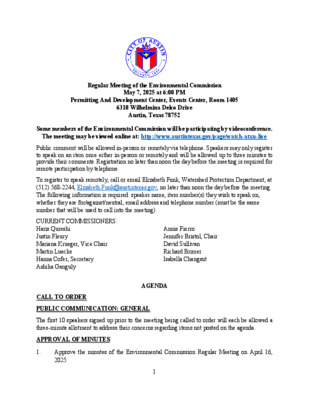
Regular Meeting of the Environmental Commission May 7, 2025 at 6:00 PM Permitting And Development Center, Events Center, Room 1405 6310 Wilhelmina Delco Drive Austin, Texas 78752 Some members of the Environmental Commission will be participating by videoconference. The meeting may be viewed online at: http://www.austintexas.gov/page/watch-atxn-live Public comment will be allowed in-person or remotely via telephone. Speakers may only register to speak on an item once either in-person or remotely and will be allowed up to three minutes to provide their comments. Registration no later than noon the day before the meeting is required for remote participation by telephone. To register to speak remotely, call or email Elizabeth Funk, Watershed Protection Department, at (512) 568-2244, Elizabeth.Funk@austintexas.gov, no later than noon the day before the meeting. The following information is required: speaker name, item number(s) they wish to speak on, whether they are for/against/neutral, email address and telephone number (must be the same number that will be used to call into the meeting). CURRENT COMMISSIONERS: Haris Qureshi Justin Fleury Mariana Krueger, Vice Chair Martin Luecke Hanna Cofer, Secretary Ashika Ganguly Annie Fierro Jennifer Bristol, Chair David Sullivan Richard Brimer Isabella Changsut CALL TO ORDER PUBLIC COMMUNICATION: GENERAL AGENDA The first 10 speakers signed up prior to the meeting being called to order will each be allowed a three-minute allotment to address their concerns regarding items not posted on the agenda. APPROVAL OF MINUTES 1. Approve the minutes of the Environmental Commission Regular Meeting on April 16, 2025 1 DISCUSSION ITEMS 2. 3. Discussion of the 2024 Watershed Protection Annual Report – Jorge Morales, Director, Watershed Protection Department Discussion of the 2024 State of Our Environment Report – Liz Johnston, Interim Environmental Officer, Watershed Protection Department PUBLIC HEARINGS 4. 5. Name: PSH – LifeWorks at Tillery, SP-2025-0031C.SH Applicant: 3423 Tillery LLC Location: 819 Tillery Street, Austin, TX, 78702 Council District: District 3 Staff: Naomi Rotramel, City Arborist, Development Services Department Applicant request: The applicant is seeking the removal of a Heritage tree with a single stem over 30 inches in diameter. Staff Recommendation: The request meets City Arborist approval criteria set forth in LDC 25-8-624(A)(2). The variance is recommended. Name: McLemore Tract Multifamily Water and Wastewater Service Extension Request #6139 and 6140 Applicant: John Lewis, Development Associate, CWS Capital Partners, LLC Location: 10656 N FM 620 Rd, Austin, Texas 78726 Council District: Not applicable Staff: Kaela Champlin, Environmental Program Coordinator, (512) 974-3443, …